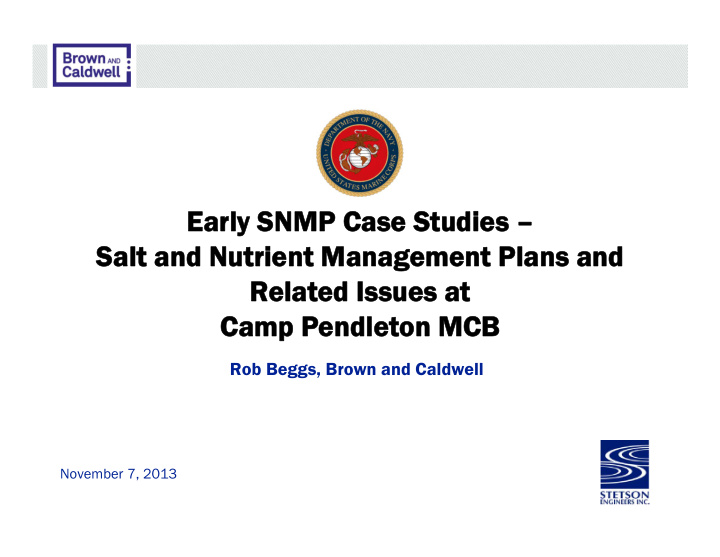



Early SNMP Case S Early SNMP Case Studies – udies – Salt and Nutrient Management Plans and Salt and Nutrient Management Plans and Relat lated Issues at d Issues at Camp P Camp Pendleton MCB ndleton MCB Rob Beggs, Brown and Caldwell November 7, 2013
Water Sustainability for Camp Pendleton
Camp Pendleton Groundwater Basins 99% of the Base’s water is • obtained from local aquifers Supplies 41,000 military and – family members on ‐ base + 60,000 commuters Southern Water System Las Flores Basin ‐‐ 1,400 acres Santa Margarita River Basin ‐‐ 4,500 acres Northern Water System San Mateo Basin ‐‐ 3,000 acres San Onofre Basin ‐‐ 1,200 acres 3
Recycled Water – Future Opportunities • Landscape Irrigation (Recreational Fields) • Base Housing and Bachelor Enlisted Quarters • Wash Racks • Indirect Potable Reuse – Groundwater Recharge • Agriculture • Salt Water Intrusion Barrier • Live Stream Discharge • Supply to Off ‐ Base Entities
South Base SNMP - Recycled Water Limitations • High TDS in raw Numerical Water Quality Objectives for the Ysidora Hydrologic Area water/Groundwater Constituent Groundwater Effluent Quality • High TDS and nutrients Total Dissolved Solids 750 1054 in recycled water Chloride 300 324 • Stringent Basin Plan Nitrate (as N) 2.3 4.5 Objectives • Pick up of TDS and nutrients in the collection system • Challenging Regulatory Environment
Groundwater Modeling SOURCES + Subflow Above Diversion Streambed Infiltration River, Tributaries Lake Releases, Ditches Recharge Pond Infiltration Areal Precipitation SINKS – Lower Ysidora Narrows Subflow Groundwater Discharge to Stream Groundwater Pumping Evapotranspiration (NO 3 ‐ N) Net Change of TDS / Na / Cl / NO 3 ‐ N Mass
Recycled Water Model Inputs • New uses of recycled water inside and outside of LSMR Basin.
Groundwater Modeling Results
South Base SNMP Results Table ES-10. Results and Considerations for Potential Future Management Strategies Management Strategy Advantages Disadvantages Obstacles and Constraints Advanced Water • Improved quality for users • High cost • Few remaining – proceeding Treatment Plant to construction • Reduces salts in wastewater • Energy usage • Enhances feasibility of other measures Salt Source Reductions • Reduces salts in wastewater • Need base order and recycled water Recycled Water Irrigation • Reduces potable water • Additional regulatory approval demands if Basin Plan objectives and Recycled Water Policy guidelines are exceeded Salt Water Intrusion • Protects Lower Ysidora • Localized groundwater quality • Additional regulatory approval Barrier effects to locally exceed Basin Plan • Reduces effluent outfall flows objectives • New wells needed to fully utilize protected subbasin Operational Changes • Significant groundwater • Higher operational costs • Pilot testing quality improvement • Higher drought risks – less • Additional management • Moderate capital costs water in storage facilities Upstream Reductions • Potentially substantial • Administratively more • Depends upon actions by groundwater quality complex outside parties – upstream improvement agencies, Regional Board, etc. • In-stream benefits • Actions taken at sources
South Base SNMP – Maximum Benefit Analysis • Associated with antidegradation analysis or a Basin Plan amendment • For possible future recycled water projects with TDS exceeding 750 mg/L, a Maximum Benefit Analysis showed several benefits and no significant constraints. • A key consideration for the salt water intrusion barrier project: no downgradient users • Analysis Results – Benefits greatly outweigh constraints
Associated and Follow-on Steps • Study and Pilot Test to Inject Recycled Water – Completed • Recycled Water Master Plan – Completed • Base Order to Discontinue water softeners – to be prepared • Off ‐ Base Stakeholders’ Workshop • Advanced Water Treatment Plant – Fall 2012 completion • Fallbrook PUD SNMP Supplement • IPR Study • North Base SNMP
Marine Corps Base Camp Pendleton Feasibility Study – • Indirect Potable Reuse (draft stage) September 25 | 2013 •
Projects Location Brown and Caldwell 14
Example of Evaluation - Percolation Recharge at Rehabilitated Pond Capacity Modeling – LSMR MODFLOW model was used with particle tracking – Max percolation capacity is 2060 AFY to avoid potential FAT requirement – SMR water diverted to Percolation Ponds may qualify as the diluent water (RWC of 20%) – Percolation for 8 months ‐ June to January – 1 year retention time to the closest well downstream Brown and Caldwell 15
Planning Level Project Costs for the Feasible Projects Projects that provide disposal capacity and additional water supply Projects that provide disposal capacity Brown and Caldwell 16
Northern Basins Salt and Nutrient Management Plan (in progress)
Northern SNMP - Calibration Run for TDS
Calibration Model Run: NO3-N
Overall Conclusions SNMPs can be part of the core planning process for: • More fully utilizing basin capacity • Recycled water projects • IPR projects • Measures to improve groundwater quality • Showing the value of upstream improvements to downstream beneficial uses • Laying out a good pathway for the regulatory approval process
Questions ????
Recommend
More recommend